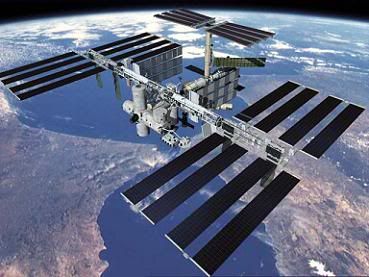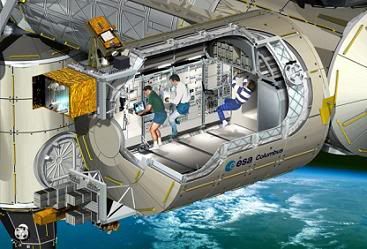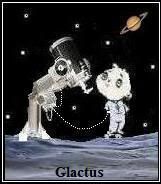Post by glactus on Oct 23, 2011 1:29:03 GMT
There is a lot about the International Space Station that the average person may not know. The activities that take place in this space outpost, the experiments that will master the biological issues relating to deep space exploration, and the refinement of those life support systems that will eventually help us in the colonization of Mars. Below are paragraphs that will explain these activities and a superb 5 minute video that will show you the interior and all about the international partners that are involved in this most important program.

The International Space Station
The International Space Station (ISS) is a habitable, artificial satellite in low Earth orbit. The ISS follows the Salyut, Almaz, Cosmos, Skylab, and Mir space stations, as the 11th space station launched, not including the Genesis I and II prototypes. The ISS serves as a research laboratory that has a microgravity environment in which crews conduct experiments in many fields including biology, human biology, physics, astronomy and meteorology.

The ESA Columbus module. A superb European contribution
The station has a unique environment for the testing of the spacecraft systems that will be required for missions to the Moon and Mars. The station is expected to remain in operation until at least 2020, and potentially to 2028. Russia's next planned space station OPSEK, is to be separated prior to the ISS's deorbit to form a new, separate space station, intended to support deep space exploration. Like many artificial satellites, the ISS can be seen from Earth with the naked eye.

The Japanese Kibô laboratory - Hi - tech research module
The ISS is operated by Expedition crews, and has been continuously staffed since 2 November 2000 - an uninterrupted human presence in space for the past 10 years and 353 days. As of September 2011[. the crew of Expedition 29 is now aboard.
The ISS combines the Japanese Kibô laboratory with three space station projects, the Soviet/Russian Mir-2, the American Freedom, and the European Columbus. Budget constraints led to the merger of these projects into a single multi-national programme. The station consists of pressurized modules, external trusses, solar arrays and other components which have been launched by Russian Proton rockets, American space shuttles, and Russian Soyuz rockets The station is maintained in orbit between 278 km (173 mi) and 460 km (286 mi) altitude, and travels at an average ground speed of 27,724 km (17,227 mi) per hour, completing 15.7 orbits per day.
The ISS is a joint project between the five participating space agencies, the American NASA, the Russian RKA, the Japanese JAXA, the European ESA, and the Canadian CSA.
To see stunning 5 minute video of the International Space Station just click on the link below. Has sound.
www.youtube.com/watch?feature=player_detailpage&v=NtrVwX1ncqk

Credits: These are NASA images.
Special credits: The National Aeronautics and Space Administration (NASA) and participating space agencies.
Text by Wikipedia/Glactus
Video by Youtube

The International Space Station
The International Space Station (ISS) is a habitable, artificial satellite in low Earth orbit. The ISS follows the Salyut, Almaz, Cosmos, Skylab, and Mir space stations, as the 11th space station launched, not including the Genesis I and II prototypes. The ISS serves as a research laboratory that has a microgravity environment in which crews conduct experiments in many fields including biology, human biology, physics, astronomy and meteorology.

The ESA Columbus module. A superb European contribution
The station has a unique environment for the testing of the spacecraft systems that will be required for missions to the Moon and Mars. The station is expected to remain in operation until at least 2020, and potentially to 2028. Russia's next planned space station OPSEK, is to be separated prior to the ISS's deorbit to form a new, separate space station, intended to support deep space exploration. Like many artificial satellites, the ISS can be seen from Earth with the naked eye.

The Japanese Kibô laboratory - Hi - tech research module
The ISS is operated by Expedition crews, and has been continuously staffed since 2 November 2000 - an uninterrupted human presence in space for the past 10 years and 353 days. As of September 2011[. the crew of Expedition 29 is now aboard.
The ISS combines the Japanese Kibô laboratory with three space station projects, the Soviet/Russian Mir-2, the American Freedom, and the European Columbus. Budget constraints led to the merger of these projects into a single multi-national programme. The station consists of pressurized modules, external trusses, solar arrays and other components which have been launched by Russian Proton rockets, American space shuttles, and Russian Soyuz rockets The station is maintained in orbit between 278 km (173 mi) and 460 km (286 mi) altitude, and travels at an average ground speed of 27,724 km (17,227 mi) per hour, completing 15.7 orbits per day.
The ISS is a joint project between the five participating space agencies, the American NASA, the Russian RKA, the Japanese JAXA, the European ESA, and the Canadian CSA.
To see stunning 5 minute video of the International Space Station just click on the link below. Has sound.
www.youtube.com/watch?feature=player_detailpage&v=NtrVwX1ncqk
Credits: These are NASA images.
Special credits: The National Aeronautics and Space Administration (NASA) and participating space agencies.
Text by Wikipedia/Glactus
Video by Youtube


